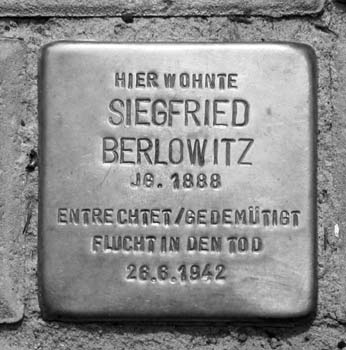Search for Names, Places and Biographies
Already layed Stumbling Stones
Suche
Siegfried Berlowitz * 1888
Hammer Landstraße 80 (Hamburg-Mitte, Hamm)
entrechtet gedemütigt
Flucht in den Tod 26.06.1942
further stumbling stones in Hammer Landstraße 80:
Werner Rosenbaum
Siegfried Berlowitz, born on 19 Feb. 1888, date of death 26 June 1942 in Hamburg
The National Socialists exerted massive pressure on the non-Jewish partners in "mixed marriages” to get divorced, something not all couples managed to withstand. For instance, the non-Jewish wife Frieda Berlowitz also got a divorce after 21 years of marriage from her "Jewish” husband Siegfried, who did not define himself as Jewish and did not belong to any Jewish community either. Probably she hoped to be able to continue supporting him while at the same time being able to live facing less harassment with her sons Günther and Klaus (at the time 21 and 22 years old), who were classified as "half-Jews (Mischlinge) of the first degree." Because of the divorce settlement, Siegfried Berlowitz lost the conditional protection afforded him by the "mixed marriage.”
He moved out of the shared apartment at Hammer Landstraße 77 to become a subtenant at Rendsburger Straße 14. Apparently, contact with the divorced wife continued, something she could support with credible evidence after the war, resulting in the State Justice Administration to annul the divorce after the war.
The couple had been married in 1920 at Königsberg, where their two sons were born as well. In 1919, Siegfried Berlowitz had started up his own business. Until then, he had worked as an authorized signatory after completing the intermediate secondary school certificate (Mittlere Reife) and commercial training. In 1930, having moved to Hamburg in the meantime, he became general manager at the Jacob Godenrath Company at the Fruchthof. In 1936, however, he was dismissed "for racial reasons” and became unemployed. In connection with the Pogrom of November 1938, he was detained from October (!) until 22 or 23 Dec. at the Sachsenhausen/Oranienburg concentration camp. In 1939 or 1940, he did six to eight weeks of forced labor at the Otterndorf Moor. From 15 Dec. 1941 onward, the Gestapo deployed him for forced labor at the Langer & Co. bag factory. On 26 June 1942, Siegfried Berlowitz hanged himself.
"The deceased repeatedly expressed thoughts of suicide to me and my husband and it is surely a case of suicide. … Apparently, B. feared that he would be evacuated, and he probably committed the act for this reason.” This is how the landlady went on record about the circumstances. No money or valuables were found, only old worn clothes, food stamps, and the identity card. Siegfried Berlowitz also left behind two notes, a power of attorney and a last will.
Siegfried Berlowitz was buried in the Jewish Cemetery in Ohlsdorf, although he had not been a member of the Jewish Community before being forced to join the Reich Association of Jews (Reichsvereinigung der Juden). His grave is not to be found, grown over by trees.
The events weighed heavily on his widow. Although she sought the help of the Association of Persons Aggrieved by the Nuremberg Laws (Notgemeinschaft der durch die Nürnberger Gesetze Betroffenen) and the Association of Persecutees of the Nazi Regime (VVN – Vereinigung der Verfolgten des Naziregimes), she became unfit for work soon after the end of the war.
Translator: Erwin Fink
Kindly supported by the Hermann Reemtsma Stiftung, Hamburg.
© Hildegard Thevs
Quellen: 4; 5; StaH, 331-5 Polizeibehörde – Unnatürliche Todesfälle; BA Bln., Volkszählung 1939; AfW 190288.


